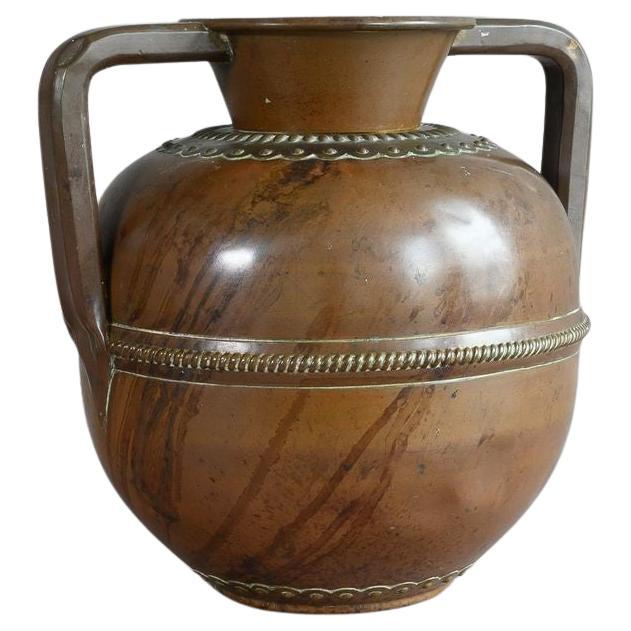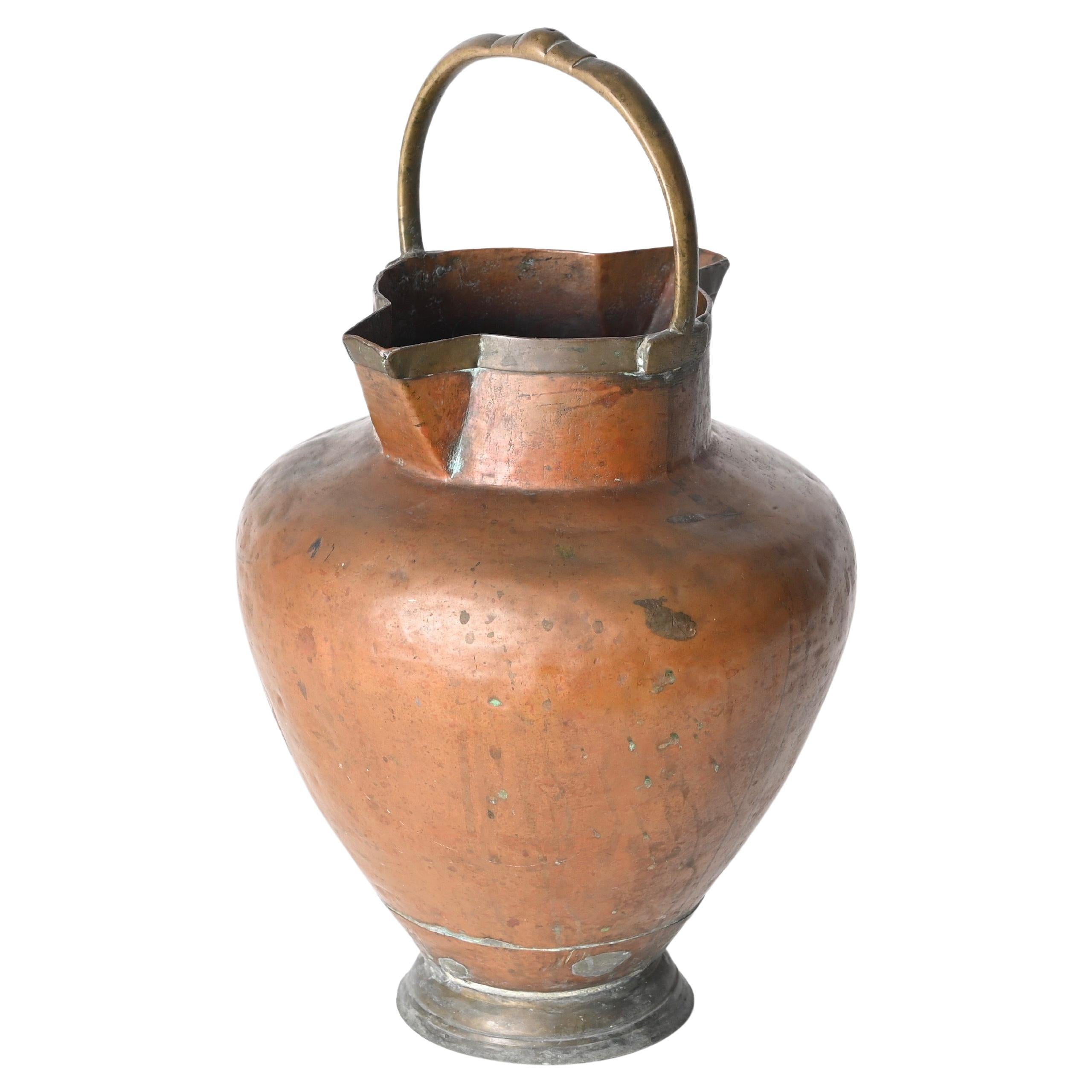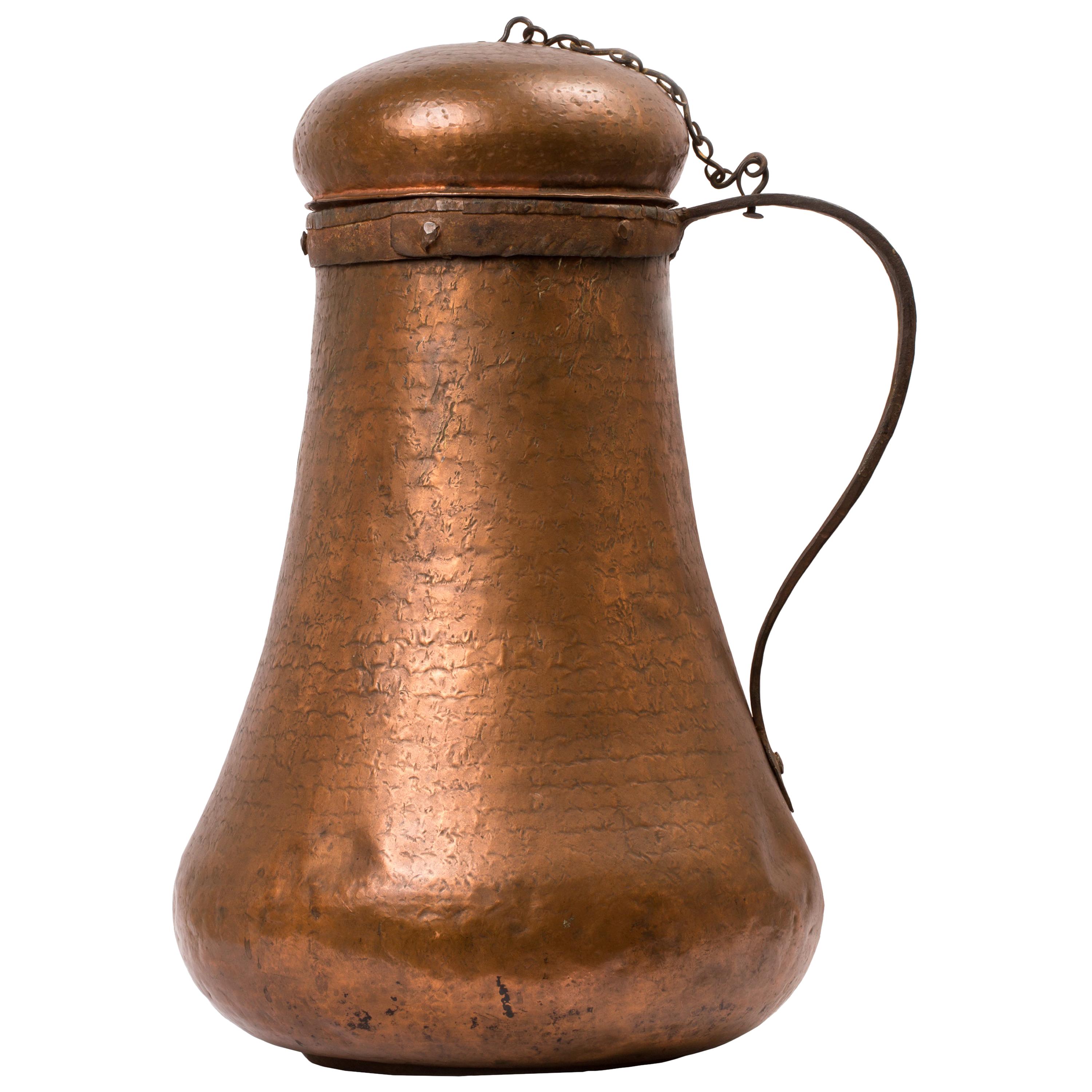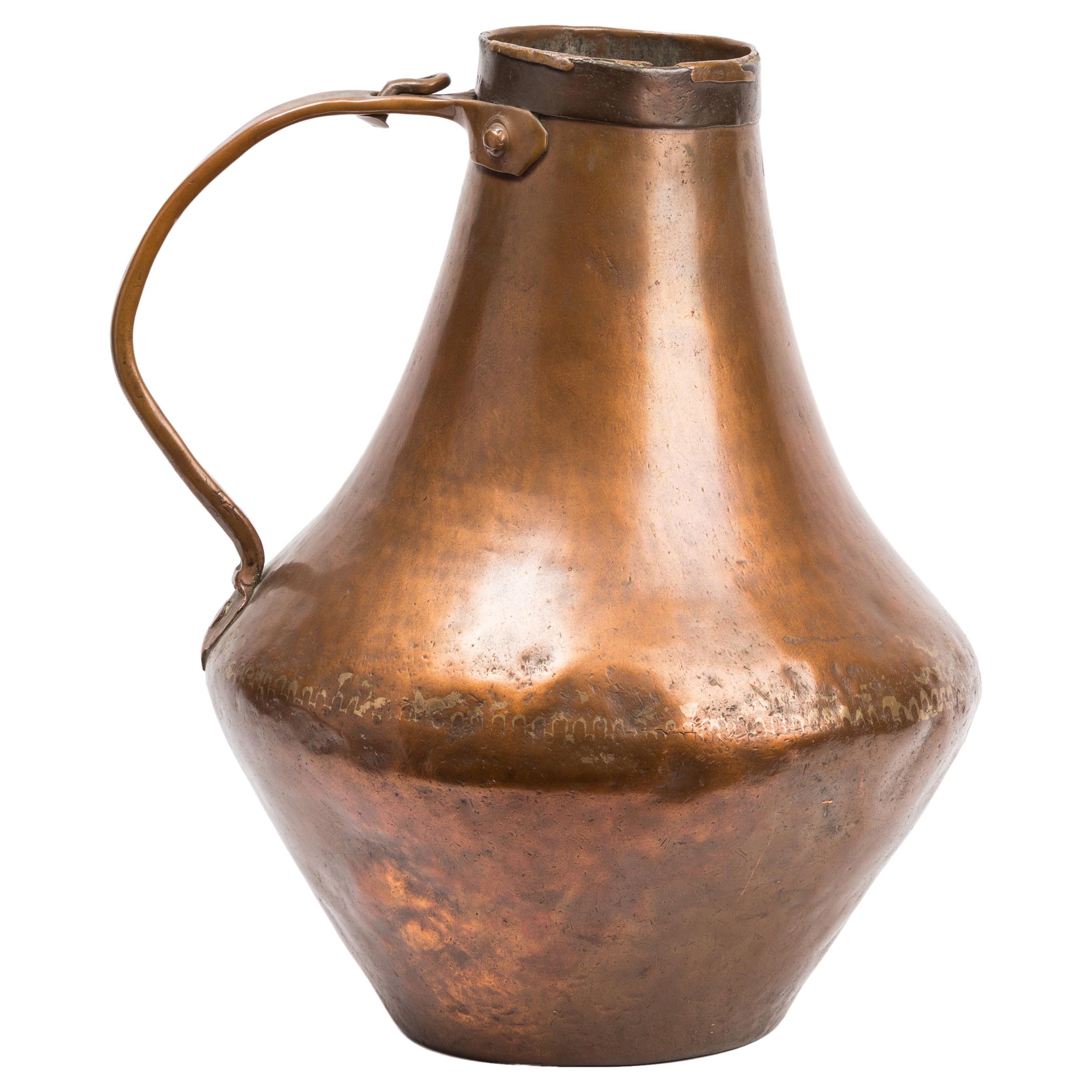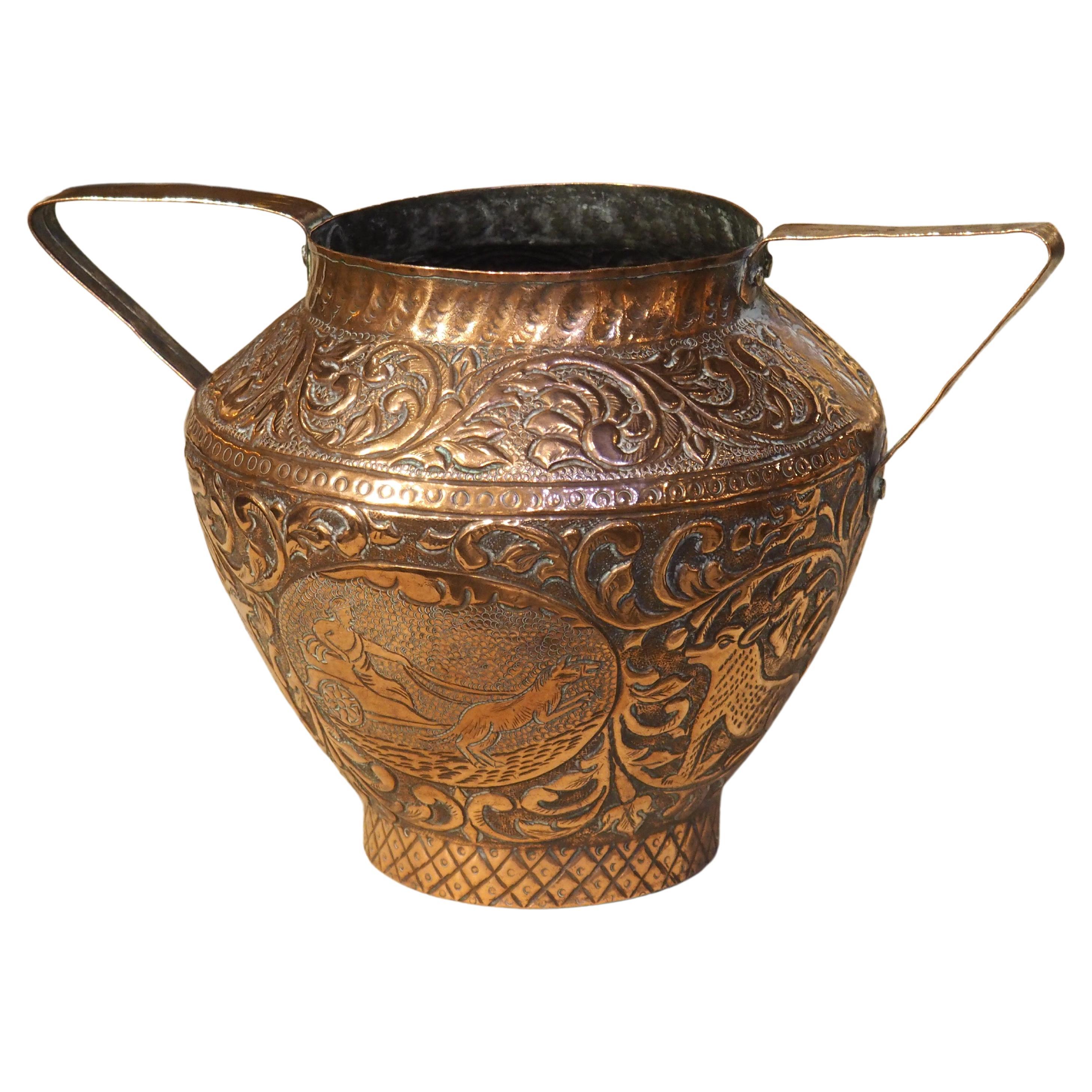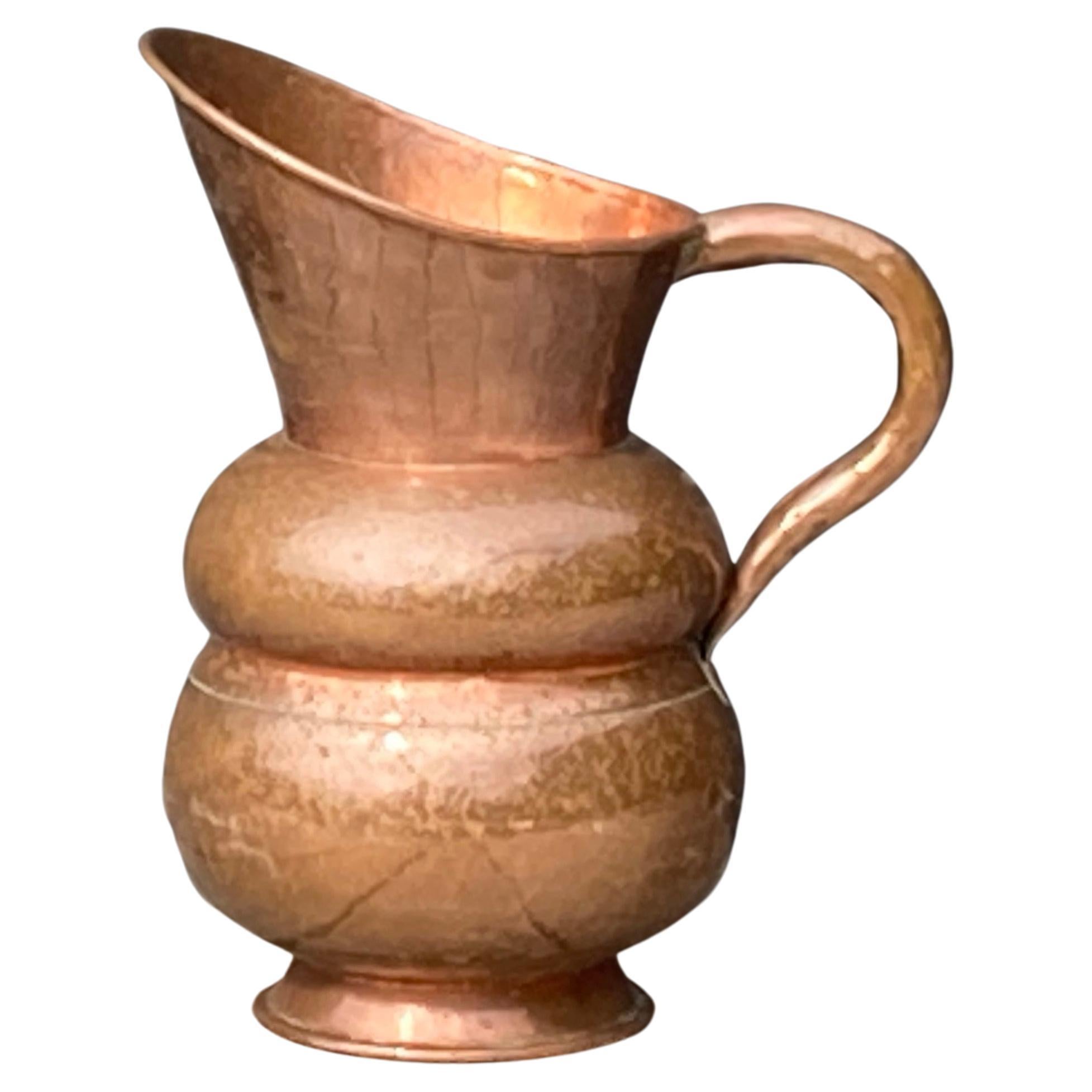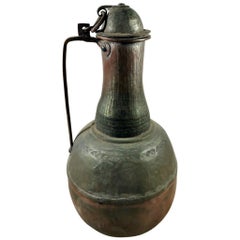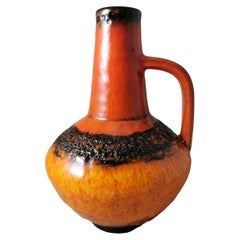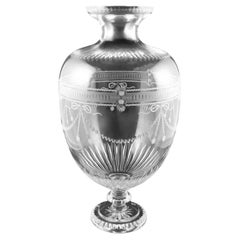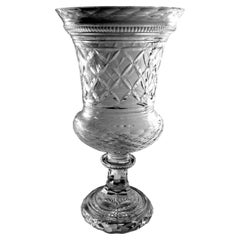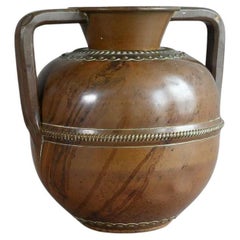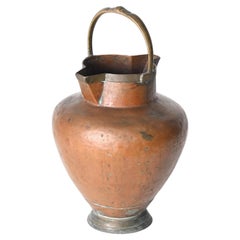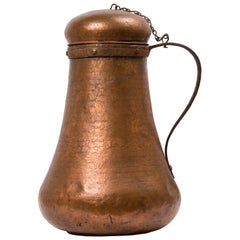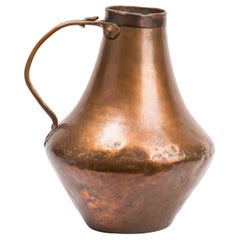Items Similar to 18th Century French Huge Copper Water Container
Want more images or videos?
Request additional images or videos from the seller
1 of 19
18th Century French Huge Copper Water Container
$1,303.99
£976.59
€1,100
CA$1,827.87
A$2,013.88
CHF 1,042.51
MX$24,247.67
NOK 13,200.67
SEK 12,401.19
DKK 8,377.87
About the Item
We kindly suggest you read the whole description, because with it we try to give you detailed technical and historical information to guarantee the authenticity of our objects.
The container has been realized in the first years of 1700 in Villedieu-les-Poeles city of Normandy (France) famous since the antiquity for the excellent production of copper; for our container has been used copper of optimal quality, hammered then to hand with great handicraft ability, the solid handles are joined to the edge by strong rivets, the used copper is of excellent quality, its thickness is very high and makes the object solid and robust (weight 9 Kg.!), the appearance is imposing almost medieval ( to understand the actual size of the object and its great functionality, look well at the two photos set with the chair). But the thing that makes the container even more interesting and attractive is the striking repair in the lower part: in the tradition of a simple conception of the rural economy, according to which nothing had to be thrown away but to be recovered, on the container a copper plate fixed with hammered rivets was roughly applied so that the functionality of the object could last many years more. Over time, hammered copper has grown a marvelous patina that together with a timeless design makes this rare and great object of 1700 attractive and highly decorative, regardless of where it will be placed will enrich the atmosphere of the space in which you find it. Measures D.cm.43, H.cm.50. For all our shipments we use special packaging materials (wooden crates, styrofoam, etc.) for maximum protection and safety of the objects.
- Dimensions:Height: 19.69 in (50 cm)Width: 16.93 in (43 cm)Depth: 16.93 in (43 cm)
- Style:Country (Of the Period)
- Materials and Techniques:Copper,Hammered
- Place of Origin:
- Period:
- Date of Manufacture:1720-1730
- Condition:Wear consistent with age and use. Antique repair on the bottom, read the description.
- Seller Location:Prato, IT
- Reference Number:Seller: 5831stDibs: LU4632221894632
About the Seller
5.0
Platinum Seller
Premium sellers with a 4.7+ rating and 24-hour response times
Established in 1977
1stDibs seller since 2019
292 sales on 1stDibs
Typical response time: <1 hour
- ShippingRetrieving quote...Shipping from: Prato, Italy
- Return Policy
Authenticity Guarantee
In the unlikely event there’s an issue with an item’s authenticity, contact us within 1 year for a full refund. DetailsMoney-Back Guarantee
If your item is not as described, is damaged in transit, or does not arrive, contact us within 7 days for a full refund. Details24-Hour Cancellation
You have a 24-hour grace period in which to reconsider your purchase, with no questions asked.Vetted Professional Sellers
Our world-class sellers must adhere to strict standards for service and quality, maintaining the integrity of our listings.Price-Match Guarantee
If you find that a seller listed the same item for a lower price elsewhere, we’ll match it.Trusted Global Delivery
Our best-in-class carrier network provides specialized shipping options worldwide, including custom delivery.More From This Seller
View AllAntique Spanish Copper Jug with Lid All Hand Forged with a Beautiful Patina
Located in Prato, Tuscany
We kindly suggest you read the whole description, because with it we try to give you detailed technical and historical information to guarantee the authenticity of our objects.
The j...
Category
Antique Early 19th Century Spanish Rustic Pitchers
Materials
Copper
Fat Lava German Colored And Glazed Ceramic Pitcher
Located in Prato, Tuscany
We kindly suggest you read the whole description, as with it we try to give you detailed technical and historical information to guarantee the authenticity of our objects.
Peculiar and original German ceramic jug colored with a beautiful shade of red, black, and a vivid orange; it has a simple shape but at the same time innovative and modernist; the beautiful and vivid colors are balanced and proportioned respecting a minimalist design; the glazing of the jar was obtained by first laying down one color, proceeding to fix it by firing it in a kiln, then the same procedure was performed for the other colors; on the bottom bears the traditional mark found on this type of object, indicating that the object was created in a limited series with the jug number and the model number; unfortunately, on our jug this mark is barely legible, but it exists and allows us to say that this object was produced between 1968 and 1971 in a craft workshop in the city of Dresden (then in East Germany), an important center of porcelain and ceramic production. "Fat lava" is the name given to a certain style of East German art...
Category
Late 20th Century German Mid-Century Modern Ceramics
Materials
Ceramic
Neoclassical Style Large Italian Crystal Vase with 18th Century Engravings
Located in Prato, Tuscany
Before describing the object under consideration, we must make an important clarification; the artifact, one of many that we will publish over time, is part of the museum collection of a historic Florentine crystal grinder that unfortunately closed recently. It is the Marcello Galgani & Son company, whose completely manual and artisanal work has not withstood the disproportionate advance of mass-produced mechanical processes! Marcello Galgani began his craft as a grinder and restorer in 1960; as the years went by, Marcello mastered and became familiar with particular techniques and shapes, resulting in the production of objects that manage to retain the freshness of grinding and engraving, the warmth and softness of light, and the inimitable flavor of unique artifacts. After several years, his son Lorenzo, who grew up among crystals, also entered the business and immediately became passionate about this ancient craft with skill and ability. Stimulated by the aesthetic sense of the past, father and son, set up a workshop in which the shapes they researched and created themselves are mouth-blown by traditional Tuscan glassmakers in Empoli, then ground and engraved using ancient sixteenth-century techniques, with motifs born from the Galgani's inexhaustible imagination or culturally inspired by designs of objects seen and studied in Florentine museums (Uffizi, Galleria Palatina, Museo degli Argenti, etc.). Marcello and Lorenzo Galgani were also Masters in the difficult art of restoration, bringing rare and precious objects back to life. As mentioned the company recently closed and disposed of all its last production, and only Marcello's old private museum collection remained, which includes unique and special objects created over time, a collection that the craftsman made available to us for a planned sale. All of the objects were made entirely by hand with old grinding wheels, but there were mainly two tools that allowed the creation of masterpieces: the right hand and the left hand of the master craftsman. Ancient glassmaking techniques were used for all the ground and engraved products: first, the object was ground with an emery wheel fed continuously by a jet of abrasive sand and water, then re-polished with a very fine-grained sandstone wheel also fed with water; the engravings were done freehand using as many as 10-15 small stone wheels for each design (flowers, branches, animals, etc. ); then the object was polished and shined; we must make, at this point, an important clarification on these last two operations: towards the end of the 1960s acid crystal polishing was devised, the object was immersed and rotated in a solution of sulfuric acid, fluoridic acid and water and in a short time all the defects left by the previous processes were eliminated, it was a fast, industrial operation that allowed to lower costs considerably, with discrete but not excellent results. But for Galgani's products polishing is done with a cork bark wheel wet with water and pumice, to make the surfaces more transparent, and finally polishing was achieved with a felt wheel wet with a paste of water, iron oxide, and cerium oxide. This series of processes takes an average of two days of work( sometimes much longer) for each object, each engraving or grinding is the result of the creative inventiveness of the two artisans, inventiveness that transforms crystal into reality material of the highest aesthetic value and inestimable value. All the items in the entire collection have never been used; they were part of the exhibition. Large crystal vase with base; the decorations, graceful and delicate, are in Neoclassical style. The object is "one-of-a-kind" signed by the Master; it was created in Marcello Galgani's workshop in 1981 and made with the techniques (grinding, engraving, and polishing) we explained in the description; for the shape, the Master was inspired by a vase found in a painting, preserved in the Uffizi Gallery in Florence by the 16th-century painter Jacopo Ligozzi...
Category
Late 20th Century Italian Neoclassical Vases
Materials
Crystal
Florentine Renaissance Style Huge Italian Cut And Ground Crystal Medici Vase
Located in Prato, Tuscany
Before describing the object under consideration, we must make an important clarification; the artifact, one of many that we will publish over time, is part of the museum collection of a historic Florentine crystal grinder that unfortunately closed recently. It is the Marcello Galgani & Son company, whose completely manual and artisanal work has not withstood the disproportionate advance of mass-produced mechanical processes! Marcello Galgani began his craft as a grinder and restorer in 1960; as the years went by, Marcello mastered and became familiar with particular techniques and shapes, resulting in the production of objects that manage to retain the freshness of grinding and engraving, the warmth and softness of light, and the inimitable flavor of unique artifacts. After several years, his son Lorenzo, who grew up among crystals, also entered the business and immediately became passionate about this ancient craft with skill and ability. Stimulated by the aesthetic sense of the past, father and son, set up a workshop in which the shapes they researched and created themselves are mouth-blown by traditional Tuscan glassmakers in Empoli, then ground and engraved using ancient sixteenth-century techniques, with motifs born from the Galgani's inexhaustible imagination or culturally inspired by designs of objects seen and studied in Florentine museums (Uffizi, Galleria Palatina, Museo degli Argenti, etc.). Marcello and Lorenzo Galgani were also Masters in the difficult art of restoration, bringing rare and precious objects back to life. As mentioned the company recently closed and disposed of all its last production, and only Marcello's old private museum collection remained, which includes unique and special objects created over time, a collection that the craftsman made available to us for a planned sale. All of the objects were made entirely by hand with old grinding wheels, but there were mainly two tools that allowed the creation of masterpieces: the right hand and the left hand of the master craftsman. Ancient glassmaking techniques were used for all the ground and engraved products: first, the object was ground with an emery wheel fed continuously by a jet of abrasive sand and water, then re-polished with a very fine-grained sandstone wheel also fed with water; the engravings were done freehand using as many as 10-15 small stone wheels for each design (flowers, branches, animals, etc. ); then the object was polished and shined; we must make, at this point, an important clarification on these last two operations: towards the end of the 1960s acid crystal polishing was devised, the object was immersed and rotated in a solution of sulfuric acid, fluoridic acid and water and in a short time all the defects left by the previous processes were eliminated, it was a fast, industrial operation that allowed to lower costs considerably, with discrete but not excellent results. But for Galgani's products polishing is done with a cork bark wheel wet with water and pumice, to make the surfaces more transparent, and finally polishing was achieved with a felt wheel wet with a paste of water, iron oxide, and cerium oxide. This series of processes takes an average of two days of work( sometimes much longer) for each object, each engraving or grinding is the result of the creative inventiveness of the two artisans, inventiveness that transforms crystal into reality material of the highest aesthetic value and inestimable value. All the items in the entire collection have never been used; they were part of the exhibition. Huge and monumental Florentine Renaissance-style vase...
Category
Late 20th Century Italian Renaissance Vases
Materials
Crystal
Fat Lava German Jug With Colored And Glazed Ceramic Handle
Located in Prato, Tuscany
We kindly suggest that you read the whole description, as with it we try to give you detailed technical and historical information to guarantee the authenticity of our objects.
Pecul...
Category
Late 20th Century German Mid-Century Modern Ceramics
Materials
Ceramic
Saint Clement Blanche Letalle French Art Deco Vase In Ceramic And Pure Gold
By Saint-Clément, Blanche Letalle
Located in Prato, Tuscany
We kindly invite you to read the entire description, as we strive to provide detailed technical and historical information to ensure the authenticity of our items.
This distinctive and captivating vase stands out for its understated Pompeian red color, admired for its exceptional elegance and plasticity. The body is adorned with linear, refined, stylized stars in relief, embellished with pure gold accents. The pottery used is glazed earthenware, and the glossy finish suggests the use of vitreous glazes to achieve a bright, uniform effect. The gilding on the stars was likely applied using the ceramic lustre technique, where gold is added at a low temperature after the initial firing, resulting in a shiny and durable finish. The vase was crafted in the Art Deco style between 1930 and 1935 at the Saint Clement pottery...
Category
Mid-20th Century French Art Deco Vases
Materials
Ceramic
You May Also Like
Copper Pot
Located in London, England
Two handled copper pot. Circa 1920
H 26.5cm x W 28cm x D 23cm
Category
Vintage 1920s Planters, Cachepots and Jardinières
Materials
Copper
$148
Italian Decorative Copper Vase or Decanter with Brass Handle, Italy, Late '800s
Located in Roma, IT
Amazing antique "mezzina" Pitcher fully made in solid copper with Brass Handle. This wonderful piece was made in Italy in the late '800s.
The way the copper and the brass aged on this decorative pitcher is simply spectacular, making this object extremely charming.
This rare jug was hand-made in solid copper with the top border and the handle made in solid brass.
An incredibly attractive object, perfect to compelment a Provence Style or a Mid-Century project.
This amazing vase is amazing because it has two spouts and a single handle and brass base. Extraordinary production from the first half of the 20th century.
In ancient times this fantastic piece was used to draw water from the well and transport it into homes, today it will be a premium element to decorate a corner of a neoclassical living room.
Category
Antique 1890s Italian Mid-Century Modern Vases
Materials
Copper, Brass, Metal
$682 Sale Price
20% Off
Large Spanish Rustic Hammered Copper Container with Cover, Wrought Iron Handle
Located in Madrid, ES
This impressive 19th century hand-hammered copper jug stands 2 feet tall, and is exceptionally stabile due to its wide based design. Originally crafted for more practical purposes, t...
Category
Antique 19th Century Spanish Rustic Planters, Cachepots and Jardinières
Materials
Copper, Wrought Iron
Antique Spanish Rustic Handcrafted Copper Pitcher, Jug, Container with Handle
Located in Madrid, ES
Hammered, riveted and soldered in 18th century Spain, this copper container was made for common household use, but with its sculptural form, rich color and patina of age it surpasses...
Category
Antique 18th Century Spanish Rustic Jars
Materials
Copper
Circa 1800 French Copper 2-Handled Vase with Chariot and Cartouche
Located in Dallas, TX
Hand-worked circa 1800, this French vase is adorned with a chariot and cartouche scene. Some of the elements were hammered from the front side, in a metalworking technique known as chasing, while other motifs were worked from the verso side, which is known as repousse. It is not uncommon for the two methods to be used in tandem, and the work of this particular artisan is top notch.
The 5 ¾ diameter opening is flanked by two flared out handles that terminate on the widest part of the main body. A flowing foliate margent (repousse) adorns the top of the body, beneath the lightly textured thick neck (chased). The leaf theme continues beneath a thin ring of roundels that frames the upper body, with a sprawling foliage display that wraps around the lower body, interrupted by a pair of cartouches. One scene depicts a man in a toga with a laurel wreath crown...
Category
Antique Early 19th Century French Vases
Materials
Metal, Copper
Large Antique 19th Century Hammered French Copper Water Jug with Handle
Located in COLMAR, FR
A wonderful antique French Water jug in copper. This handmade jug dates from the late-19th Century and is a great exemple of craftsmanship from this era. Most likely made by a local ...
Category
Antique Late 19th Century French French Provincial Urns
Materials
Copper
More Ways To Browse
Antique Container
Antique Containers
Antique French Country Dining Room Set
Water Vase
Antique Copper Vessels
Antique Furniture Containers
Antique Water Vessel
Antique Handicrafts
Water Jar
French Early 18th Century Chairs
18th Century French Dining Chairs
18th Century French Vases
Hammered Copper Vases
Hammered Copper Vessel
18th Century French Copper
Antique Water Jar
Antique Hammered Copper Vase
Antique Water Containers
